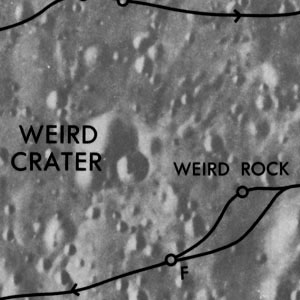Weird
Contents
[hide]Weird (Apollo 14 site craterlet name)
|
Lat: 3.7°S, Long: 17.5°W, Diam: 0 km, Depth: km, Rükl: 42 |
Apollo 14 Site Traverses Chart "Weird" refers to the cluster of two or three craters. The adjacent name "Weird Rock" was not adopted by the IAU.
Orbital images of Weird crater
LPOD Photo Gallery Lunar Orbiter Images Apollo Images
Surface photographs of Weird rock
Distant Weird rock is seen near the centre of Hasselblad frame AS14-64-9146.
According to David M. Harland and his book Exploring the Moon - the Apollo expeditions, close-ups of Weird rock were made on Hasselblad frames AS14-64-9134, 9135, and 9136.
Post Apollo-era photography of both Weird crater and Weird rock
Weird crater and Weird rock photographed by the LRO - Lunar Reconnaissance Orbiter (source: ALSJ).
Maps
(LAC zone 76B1) LAC map Geologic map LM map AIC map
APOLLO LUNAR SURFACE JOURNAL (ALSJ) maps of Weird crater and environs:
Weird crater and area east of LM Antares
Weird crater, plus the North and Center members of Triplet crater
Location of Weird rock related to Weird crater
Weird crater and Stations F and G
Description
The odd shape of Apollo 14's Weird crater is somewhat the same as Apollo 17's Victory crater. Such irregular shaped craters are good signposts for those who want to find their way on, for example, the orbital high-resolution photographs made by the Fairchild and Itek cameras of Apollo 15, 16, and 17, and also by the cameras of the Lunar Reconnaissance Orbiter.
Description: Wikipedia
(no Wikipedia page for Apollo 14's Weird).
Additional Information
Nomenclature
Astronaut-named feature, Apollo 14 site.
LROC Articles
Not related to Apollo 14's Weird crater, but perhaps it's interesting to know something about the existence of another Weird southeast of farside crater Koch. See the LROC's RDR Products item number 9 on the 33d page:
Weird crater southeast of Koch.
Bibliography
Alice J. Hall: APOLLO 14, the climb up Cone crater (National Geographic, July 1971).
David M. Harland: EXPLORING THE MOON, the Apollo expeditions.
Eric M. Jones: APOLLO LUNAR SURFACE JOURNAL (ALSJ).
